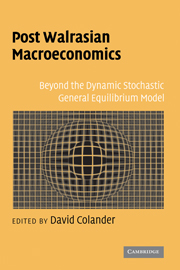Book contents
- Frontmatter
- Contents
- List of Contributors
- Foreword by Alan Kirman
- Introduction
- PART I WHERE WE ARE IN MACRO AND HOW WE GOT THERE
- 1 Episodes in a Century of Macroeconomics
- 2 Post Walrasian Macroeconomics: Some Historic Links
- 3 The Problem of Time in the DSGE Model and the Post Walrasian Alternative
- 4 Who Is Post Walrasian Man?
- PART II EDGING AWAY FROM THE DSGE MODEL
- PART III LEAPING AWAY FROM THE DSGE MODEL
- PART IV LETTING THE DATA GUIDE THEORY
- PART V POLICY IMPLICATIONS
- Bibliography
- Index
3 - The Problem of Time in the DSGE Model and the Post Walrasian Alternative
Published online by Cambridge University Press: 02 December 2009
- Frontmatter
- Contents
- List of Contributors
- Foreword by Alan Kirman
- Introduction
- PART I WHERE WE ARE IN MACRO AND HOW WE GOT THERE
- 1 Episodes in a Century of Macroeconomics
- 2 Post Walrasian Macroeconomics: Some Historic Links
- 3 The Problem of Time in the DSGE Model and the Post Walrasian Alternative
- 4 Who Is Post Walrasian Man?
- PART II EDGING AWAY FROM THE DSGE MODEL
- PART III LEAPING AWAY FROM THE DSGE MODEL
- PART IV LETTING THE DATA GUIDE THEORY
- PART V POLICY IMPLICATIONS
- Bibliography
- Index
Summary
The new DSGE synthesis in macroeconomics is nicely captured in Michael Woodford's Interest and Prices (2003), which pulls together many strands from an immense literature that has grown up over the last two decades. Woodford's book can be seen as the culmination of attempts to establish a new “neoclassical synthesis” that combines the best of the New Classical and Real Business Cycle literature that rose to prominence in the decade of the 1980s, with the best of the New Keynesian literature that rose up in reaction during the decade of the 1990s. Woodford is quite explicit about this. The Real Business Cycle model is, for him, the benchmark. It shows us how it is possible to understand output fluctuation as an equilibrium response to taste and technology shocks. But it can't explain everything we see, in particular VAR evidence that monetary impulses (both anticipated and unanticipated) have real effects (pp. 174–5). This evidence provides room for a New Keynesian elaboration of the RBC model to include sticky nominal prices and wages. The end result is a model that, because it is built from optimizing microfoundations, is immune to the Lucas (1976) critique of old-style Keynesian econometric models, but is nonetheless also able actually to fit (not just to calibrate) the data.
The point of reviving the neoclassical synthesis is not however primarily to influence academic economics. Rather, the central ambition of the book is to influence policy by providing a framework for policy analysis and discussion by practical central bankers.
- Type
- Chapter
- Information
- Post Walrasian MacroeconomicsBeyond the Dynamic Stochastic General Equilibrium Model, pp. 70 - 79Publisher: Cambridge University PressPrint publication year: 2006
- 6
- Cited by



